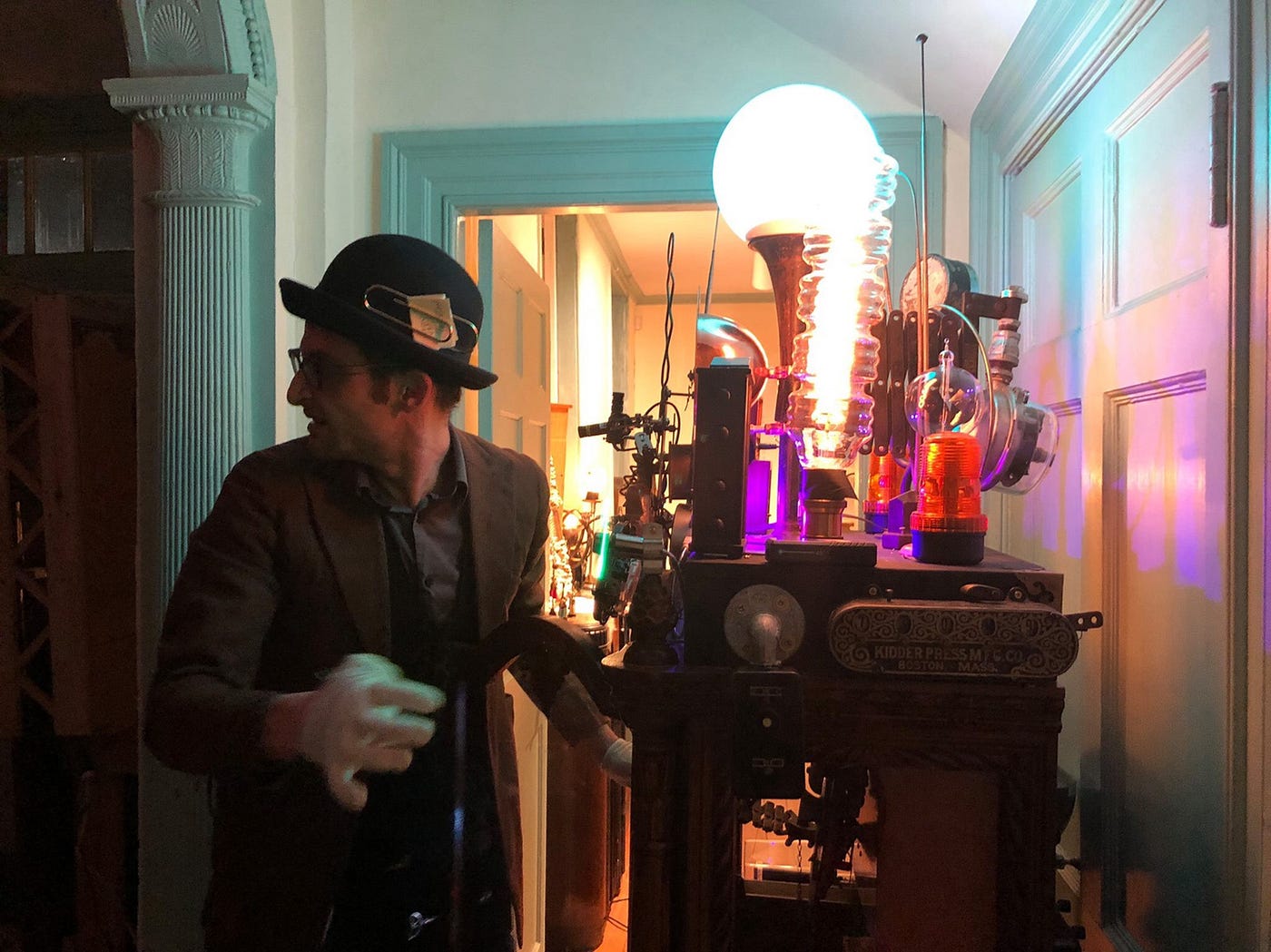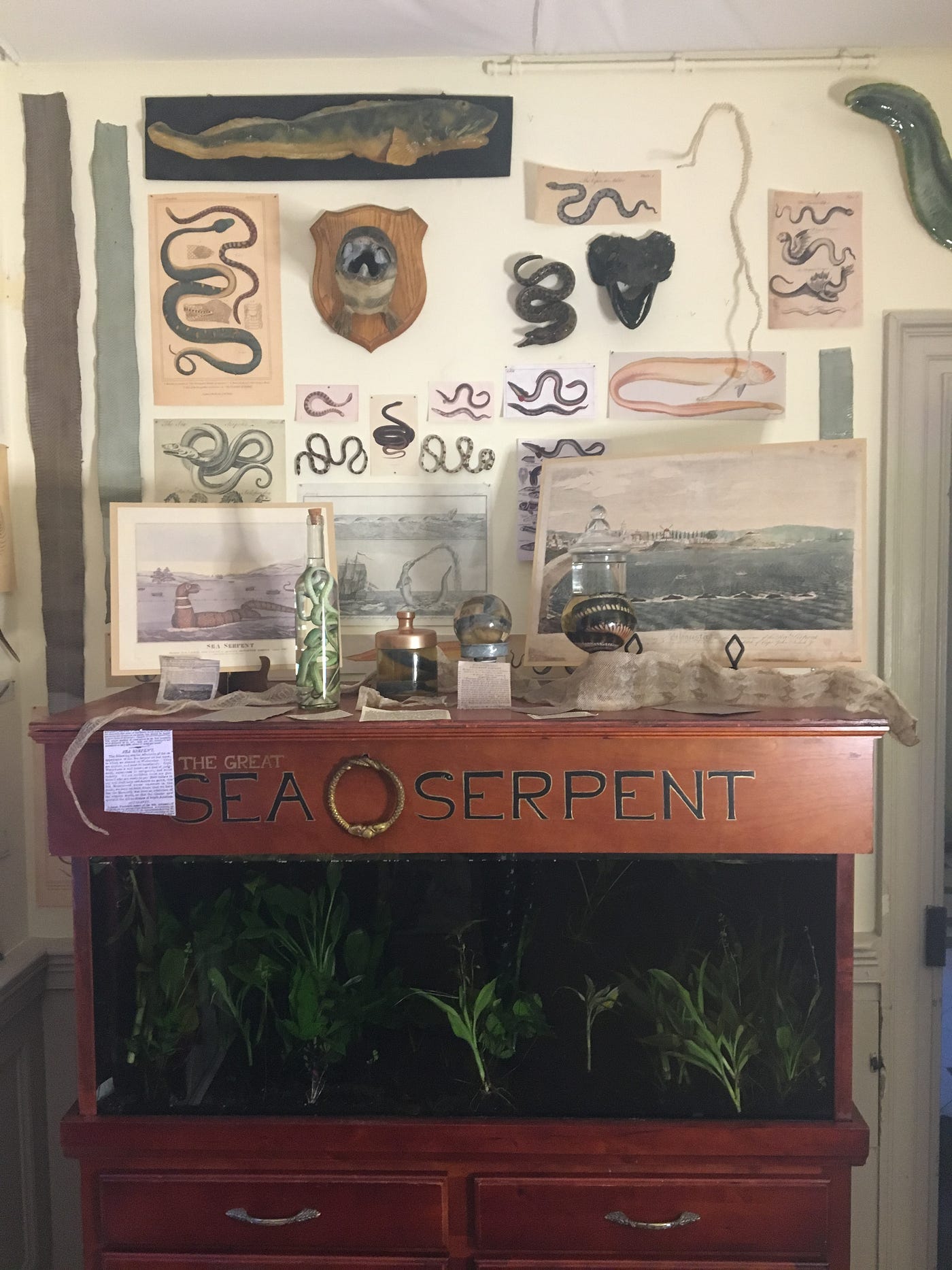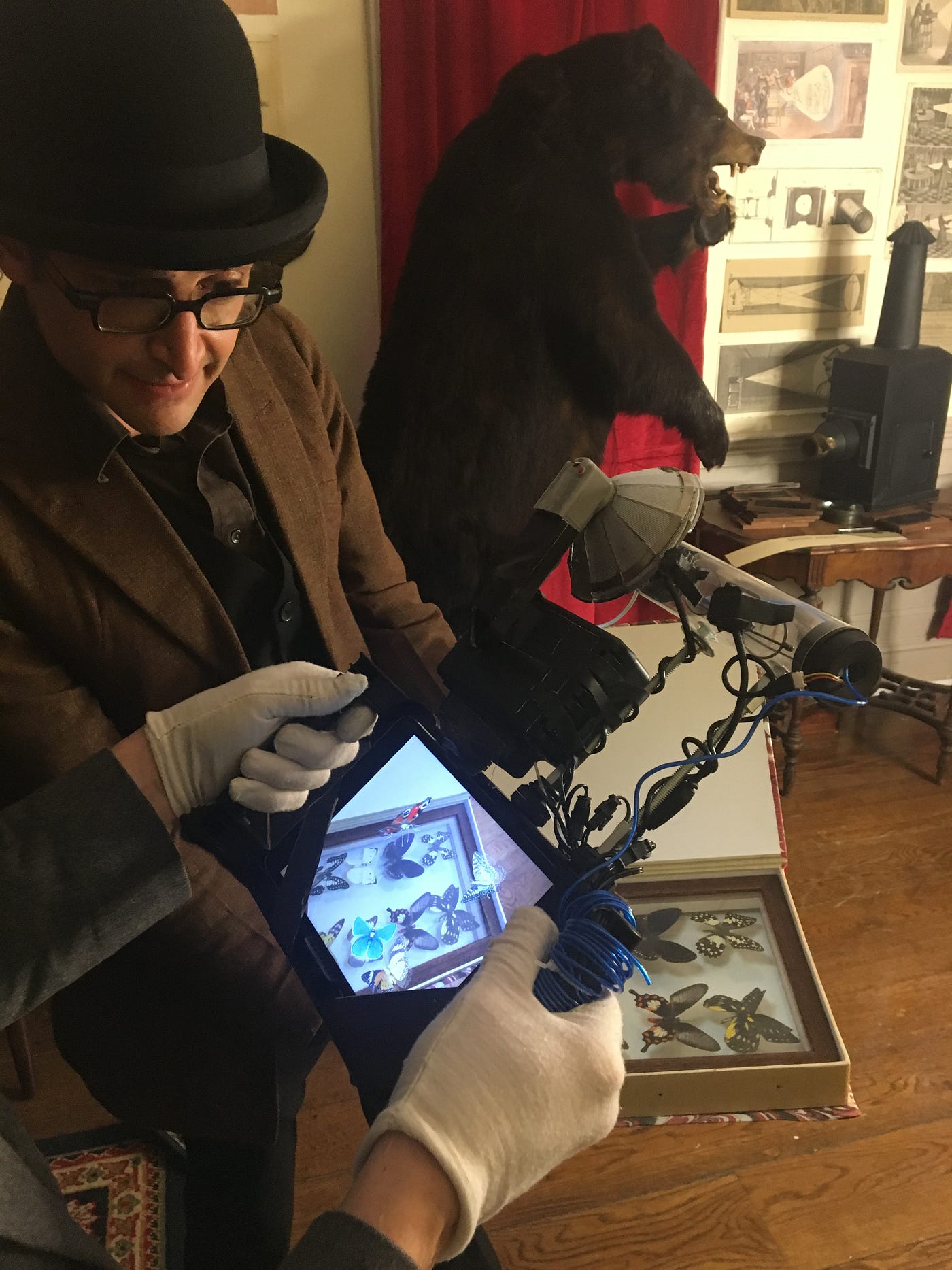Magician, historian, and storyteller David London tells us a bit about this mysterious new experience
We first became aware of David London’s interactive work in Baltimore with his piece HUMBUG: The Great P.T. Barnum Séance which showed at the Peale Center last year; as the first purpose-built museum in the USA, the venue has taken on a new life in recent years as a host of other site-specific and immersive events, including multiple productions from Submersive Productions. So we were quite intrigued when a recent communication from the Peale advertised a a “200 year time travel machine” that would somehow provide a guided tour of Rembrandt Peale’s study in the year 1819. What exactly’s been going in at the Peale?
Well, it took some arm-twisting and finagling but NoPro was able to get some details from Mr. London about the new experience as well as some unauthorized photos from a secret source (shhhh). Find out exactly how you too can travel through both space and time, below.
This interview has been lightly edited for clarity.
No Proscenium (NP): Can you tell us a little about yourself and your background in the immersive arts? How did you come to be a Certified Time Travel Agent?
David London (DL): I discovered that I was a magician when I was 7 years old, and have since been on a nearly 30-year quest to understand just what that means. Early on in my path, I realized that magic was an incredibly effective tool to tell stories and explore ideas. My explorations as a magician have all diverged from there. About 10 years ago, I decided that I needed to develop a deeper understanding of wonder, and in response, created my first interactive experience — facilitating the construction of Wonder Bread Sculptures. This taught me that fostering creativity can be a more direct and universal path to a magical experience than most “tricks.”
Though I still (and always will) continue to create and perform theatrical and storytelling-based magic shows, I have become more and more interested in creating other forms of wonder-based experiences as well, and over the past 10 years have created games, interactive installations, a theatrical dinner experience, a surrealist garden party, and several séances. In late 2017, I was hired by the Jewish Museum of Maryland to curate my first museum show, Inescapable: The Life & Legacy of Harry Houdini, which closes next week in Baltimore before it travels to Atlanta, Milwaukee and beyond. Around the same time, I began working with the Peale Center in Baltimore — the oldest building in America built to be a museum. Suddenly finding myself deeply entrenched in the museum world, I feel like I have found a new home in these storytelling institutions which, from there earliest days, combine entertainment, education, curiosity, wonder and play.

NP: What, in a nutshell, are the Time Travel Tours about? Is this an escape room? Immersive theatre? Something else?
DL: Time Travel Tours are part interactive exhibit, part puzzle, and part performance. On a purely practical level, they are guided tours, which begin with telling some of the amazing history of the Peale Museum in Baltimore, and end in an interactive exhibition which recreates what I imagine to be Rembrandt Peale’s study in the year 1819. Once we find ourselves back in time, participants are invited to explore the room, and are invited to pick up objects, open drawers, rummage through papers, etc. The performance aspect of the tour provides context, and illuminates what visitors encounter.
Though these parts of the experience are all based on historic fact, there is a science fiction component to Time Travel Tours as well. After receiving a brief historic overview of the Peale, and before traveling back in time, visitors enter the Escapement Time Travel Agency. Here, they learn about the discovery, history and methods of Time Travel, and then must work together to find the necessary information and keys to active our 200-Year Time Machine, which works by transforming a doorway into a portal into the past. Once we travel back, we bring with us some future technology, which allows for illumination, sound, as well as a device which allows us to see what Rembrandt Peale saw 200 years ago, utilizing Augmented Reality.
The entire experience from beginning to end is led by a tour guide (presently me), and participants are fully engaged in a world they can touch, so it could be classified as both immersive theater as well as an immersive environment/ exhibit. And though there is a puzzle element to the tours, and activating the Time Machine is an essential aspect to the overall experience, I like to think of it more like an inverse escape room — you must solve the puzzle to get into the room, as opposed to get out!
NP: Why did you create this experience? What inspired you?
DL: Over the past 18 months, I curated the Houdini exhibit, as well as another show at the Peale early last year called HUMBUG: The Great P.T. Barnum Séance. For the first time in my creative life, these two projects required me to get deeply lost in history. After over 25 years of creating worlds entirely from my own imagination, I experienced a new kind of excitement and passion in making shows based on real life people and events. I found that my creativity was set free in a new way, as I was able to build off incredibly deep and rich stories.
While researching Houdini at the end of 2017, I spent several days digging through archives at New York Public Library, where I fell in love with the process of historical research. Afterwards I began joking with my friends that I had finally realized that I was a time traveler. At first, I simply meant this metaphorically, but then that metaphor became an obsession. I simultaneously began working with the Peale Center, where I also serve as Director of Operations. It was an easy leap to choose to engage in the rich history of the Peale, and create a site-specific experience exploring the history of the amazing building and its founder.

NP: What’s surprised you the most during the process of making the Time Travel Tours?
DL: On the outset of this project, I could not have guessed just how much I have come to learn about Baltimore, America and the World in the very tiny and specific timeframe of 1818 and 1819, and I certainly could not have imagined what a magical and transformative time this was. I continue to be captivated and inspired by what the Peale family was bringing into the world and offering to the public 200 years ago, and how forward thinking and ahead of their time the entire Peale family was. Though the Peale’s are often considered to be the first family of American artists, I frequently find myself wondering if perhaps they weren’t also some of America’s very earliest Time Travelers!
I certainly didn’t know I would be encountering and recreating a world filled with sea monsters, phantasmagorias, crazy contraptions, bizarre experiments, weird inventions and wild beasts, and found myself surprised and enchanted with each new discovery.
Each area inside Rembrandt Peale’s study also became a mini-obsession of mine, as I tried to learn everything I could about each subject, to recreate it in the most historically accurate way possible. At times, I couldn’t help but feel like in creating this I had given myself the opportunity to experience some of the passion, excitement, and obsession that Rembrandt Peale himself felt 200 years ago in the very same building.

NP: How is the audience incorporated into the work? How are you designing around audience agency, consent, and safety?
DL: At times, the audience take a more passive role, taking in the information and history of the Peale family and their museums. Other times, they are leading the experience, serving as co-explorers of the world in which we find ourselves. And inside the Escapement Time Travel Agency, they are set free to work together to find the necessary information and tools to activate the time machine.
Safety and accessibility are top priorities for all work I present, and while the Peale Center is in the midst of a capital campaign, with the installation of an elevator as our top priority, I have ensured that this entire experience takes place on the first floor of the building, to remain open to all guests. In terms of consent, there is no physical contact during the experience, and I am constantly reading our guests to gauge their level of comfort and engagement, and adjusting the tours accordingly. Years of working with audiences on stage has prepared me to ensure the safety, comfort, and enjoyment of all time travelers who visit the Peale.
NP: What’s the audience response been like so far to the Time Travel Tours?
DL: All of our audiences have been engaged, entertained, and certainly learned something new from their Time Travel Tours. We have intentionally kept our public facing information vague, but intriguing, so most guests don’t know exactly what to expect, but never leave disappointed. Maintaining the mystery of the world they will encounter has proven to be a useful tool to raise intrigue, and keep their level of curiosity, discovery and play incredibly strong throughout the entire experience.
NP: Who is the ideal audience member for this experience?
DL: I think fans of history, science fiction, technology, wonder and play are all ideal audiences, though its hard for me to imagine someone who would not be able to take something away from their Time Travel Tour. We recommend the tours for time travelers over the age of 12, mostly because many of the artifacts that are encountered in Rembrandt’s study are old, rare, and/ or fragile. Last week a friend brought her 7 year old through, and he was just as engaged as the adults, though I stand by my age requirement for time travelers.

NP: What do you hope participants take away from the Time Travel Tours?
DL: At the end of each tour I pose a question: Why are we here? And though the question is designed to get people to think about the significance and purpose of traveling back to 1819, the question is also completely genuine, and one that I don’t necessarily have the answer to myself (at least, not yet)! There are many insights that can be drawn from the tours, and our visitors continually surprise me with the depth and thoughtfulness of their own responses to my inquiry.
Certainly, I hope participants will experience the same sense of wonder, curiosity, and awe that Rembrandt Peale hoped his museum would cultivate when he opened it in 1815. As in all of my creative pursuits as a magician, I hope to also facilitate the experience of wonder, play, and creativity, which I see as basic human drives, though they are often lacking from modern life. And I hope participants learn something new about the amazing history of our building, city and country at a radically transformative time in the world.
To answer this question more succinctly, I feel particularly drawn to the text that can be found on an early advertisement for the Peale Museum in Philadelphia, which Rembrandt keeps nailed above his desk inside his study. I point this out during each tour, shortly after we arrive in 1819, and though it was written nearly 200 years ago, I don’t think I could have said it better myself: “Amusement here with science is combined, to please, improve and cultivate the mind.”
Time Travel Tours books now through March 3 at the Peale Center in Baltimore. Tickets are $15 —25 .
NoPro is a labor of love made possible by our generous Patreon backers: join them today!
In addition to the No Proscenium web site, our podcast, and our newsletters, you can find NoPro on Twitter, Facebook, YouTube, Instagram, in the Facebook community Everything Immersive, and on our Slack forum.
Office facilities provided by Thymele Arts, in Los Angeles, CA.




















Discussion